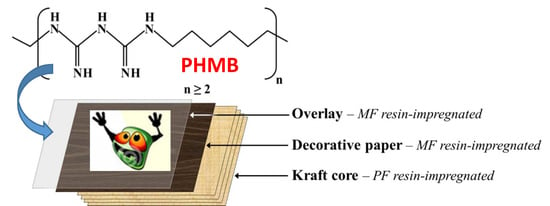High Pressure Laminates with Antimicrobial Properties
Abstract
:1. Introduction

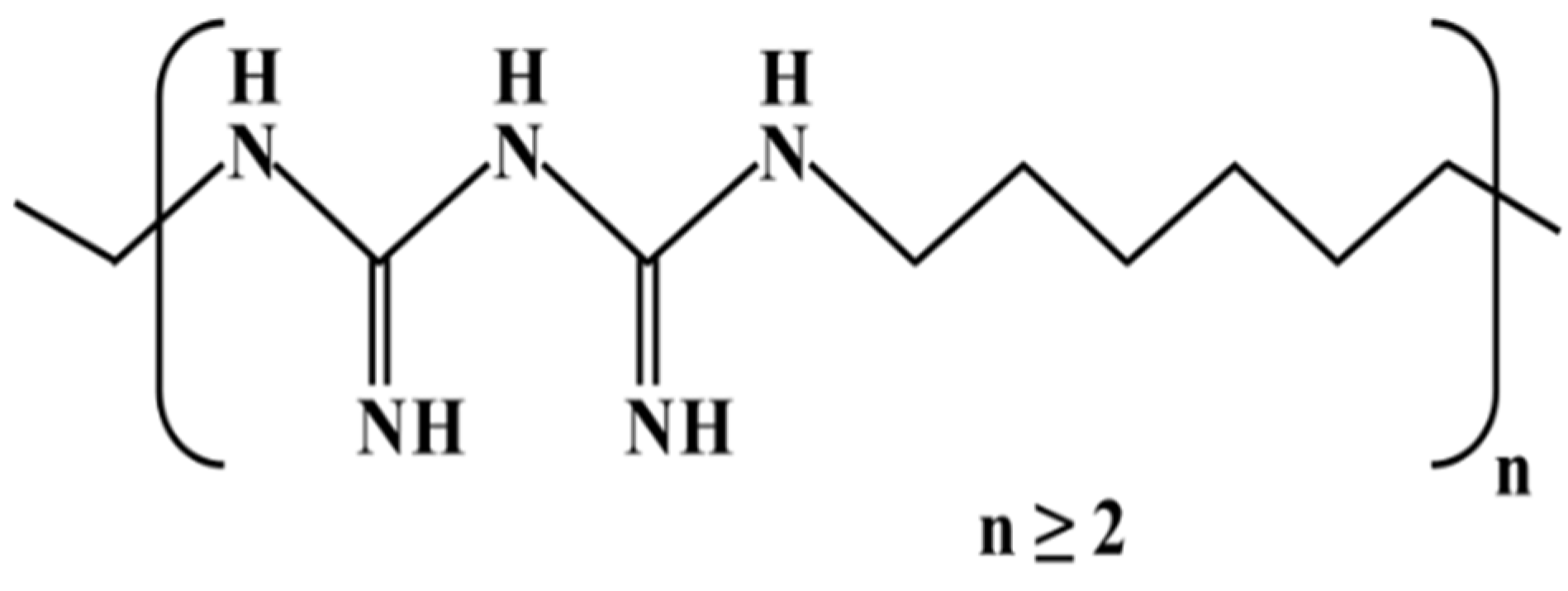
2. Results and Discussion
2.1. Characterization of HPLs Containing PHMB
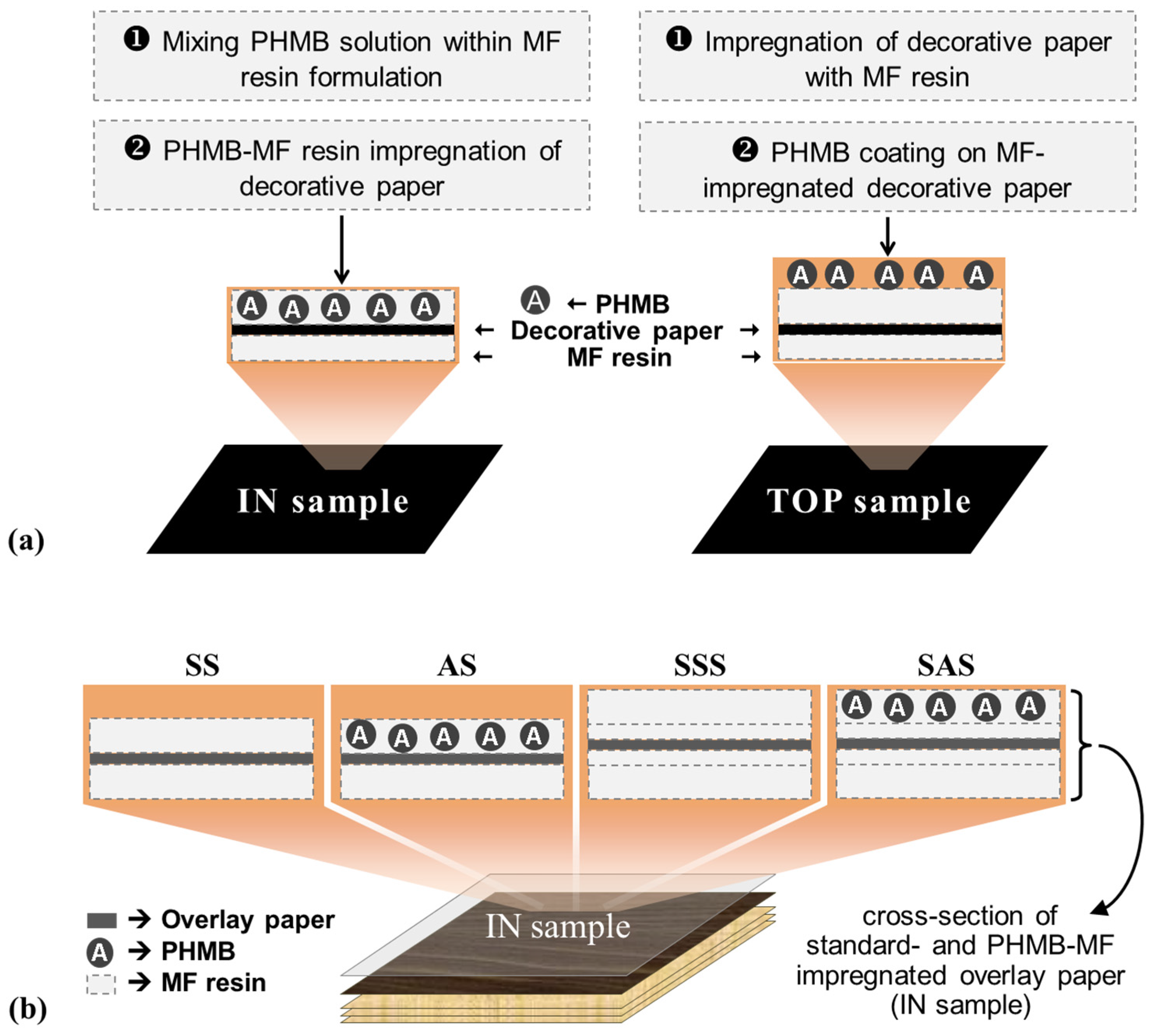

| Physical Property | Test Method [28] | Required Rating | Rating * |
|---|---|---|---|
| Resistance to immersion in boiling water | EN 438-2:12 | ≥4 | 4 |
| Resistance to water vapour | EN 438-2:14 | ≥4 | 5 |
| Resistance to dry heat (180 °C) | EN 438-2:16 | ≥4 | 4 |
| Resistance to impact by small diameter ball | EN 438-2:20 | ≥20 N | 30 N |
| Resistance to scratching | EN 438-2:25 | ≥4 | 3 |
| Resistance to staining (groups 1, 2 & 3) | EN 438-2:26 | ≥4 | 5 |
2.2. Antimicrobial activity of HPLs Containing PHMB
2.2.1. Qualitative Evaluation of the Antimicrobial Activity of Decorative Paper Laminates (DPL)
2.2.2. Quantitative Evaluation of the Antimicrobial Activity of DPL
 Below detection limit).
Below detection limit).
 Below detection limit).
Below detection limit).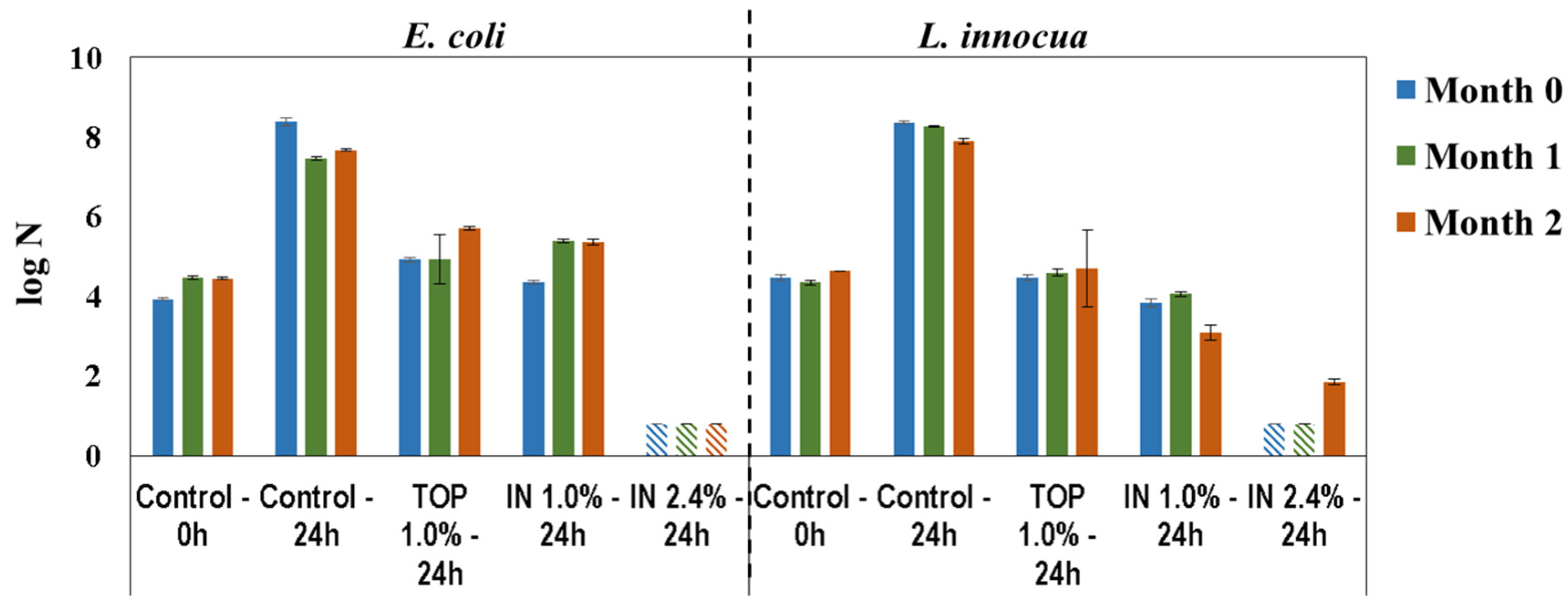
2.2.3. Quantitative Evaluation of Antimicrobial Activity of PHMB-HPLs
 , Below detection limit).
, Below detection limit).
 , Below detection limit).
, Below detection limit).
 , Below detection limit).
, Below detection limit).
 , Below detection limit).
, Below detection limit).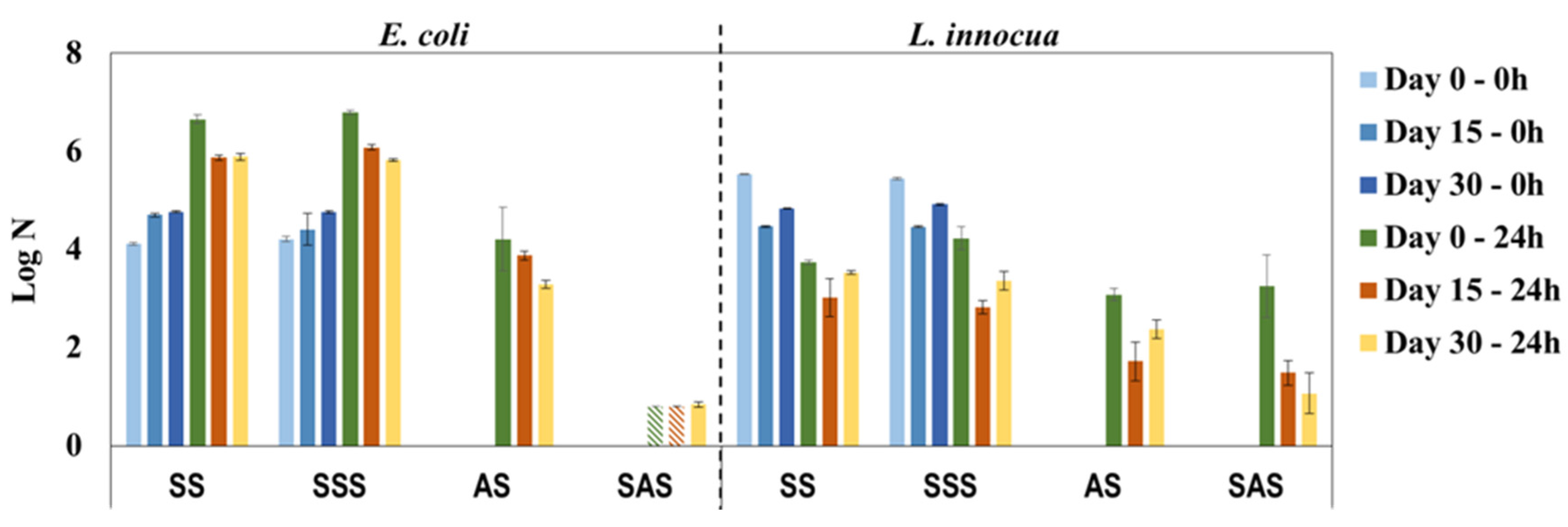
 , Below detection limit).
, Below detection limit).
 , Below detection limit).
, Below detection limit).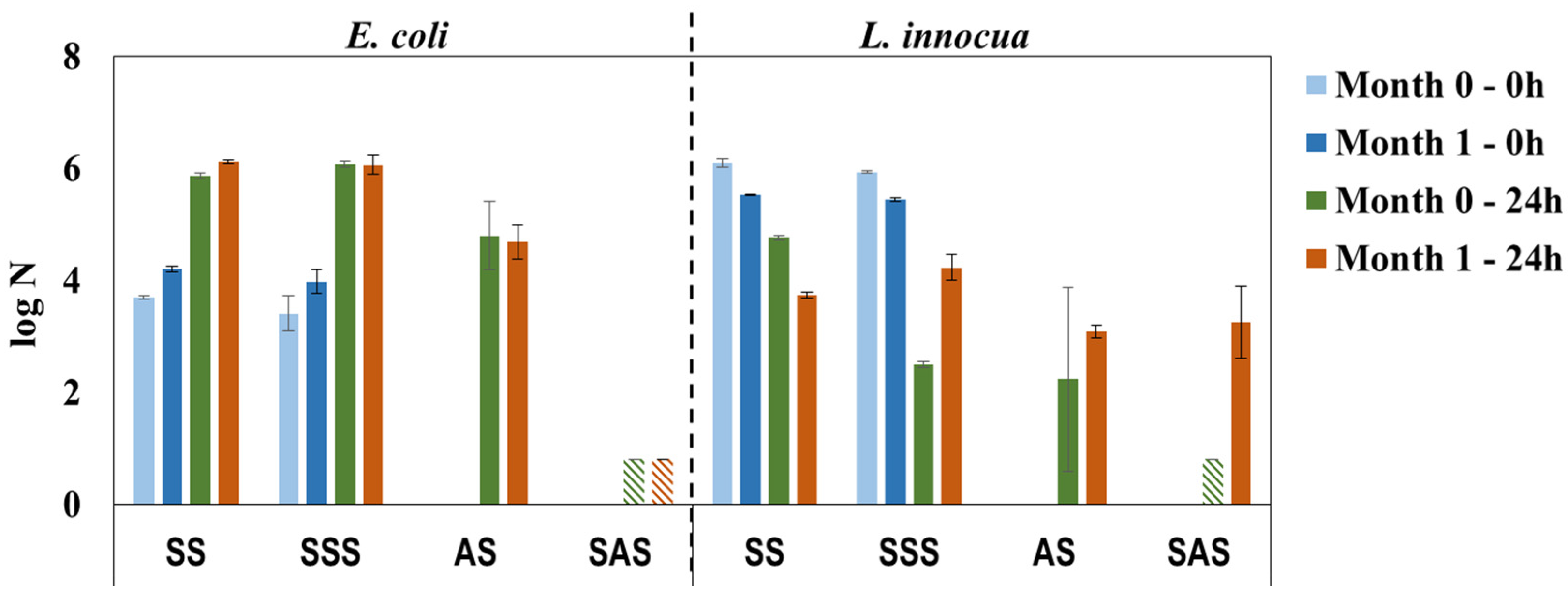
3. Experimental Section
3.1. Materials
3.2. Methods
3.2.1. Production and Characterization of HPLs
3.2.2. Evaluation of Antimicrobial Activity of PHMB-HPLs

4. Conclusions
Acknowledgments
Author Contributions
Conflicts of Interest
References
- Hunter, W.M. Decorative Laminates. In Plastics: Surface and Finish; Pinner, S.H., Simpson, W.G., Eds.; Butterworth & Co. Ltd.: London, UK, 1971; pp. 187–216. [Google Scholar]
- Figueiredo, A.B.; Evtuguin, D.V.; Monteiro, J.; Cardoso, E.F.; Mena, P.C.; Cruz, P. Structure-surface property relationships ofkraft papers: Implication on impregnation with phenol-formaldehyde resin. Ind. Eng. Chem. Res. 2011, 50, 2883–2890. [Google Scholar] [CrossRef]
- Beumer, R.R.; Kusumaningrum, H. Kitchen hygiene in daily life. Int. Biodeterior. Biodegrad. 2003, 51, 299–302. [Google Scholar] [CrossRef]
- Kramer, A.; Schwebke, I.; Kampf, G. How long do nosocomial pathogens persist on inanimate surfaces? A systematic review. BMC Infect. Dis. 2006, 6, 130. [Google Scholar] [CrossRef] [PubMed]
- Hasan, J.; Crawford, R.J.; Ivanova, E.P. Antibacterial surfaces: The quest for a new generation of biomaterials. Trends Biotechnol. 2013, 31, 295–304. [Google Scholar] [CrossRef] [PubMed]
- Kandelbauer, A.; Widsten, P. Antibacterial melamine resin surfaces for wood-based furniture and flooring. Prog. Org. Coat. 2009, 65, 305–313. [Google Scholar] [CrossRef]
- Kim, S.; Kim, H.J. Anti-bacterial performance of colloidal silver-treated laminate wood flooring. Int. Biodeterior. Biodegrad. 2006, 57, 155–162. [Google Scholar] [CrossRef]
- Lin, G.H.Y.; Hemming, M. Ocular and dermal irritation studies of some quaternary ammonium compounds. Food Chem. Toxicol. 1996, 34, 177–182. [Google Scholar] [CrossRef]
- Dann, A.B.; Hontela, A. Triclosan: Environmental exposure, toxicity and mechanisms of action. J. Appl. Toxicol. 2011, 31, 285–311. [Google Scholar] [CrossRef] [PubMed]
- Fang, J.L.; Stingley, R.L.; Beland, F.A.; Harrouk, W.; Lumpkins, D.L.; Howard, P. Occurrence, efficacy, metabolism, and toxicity of triclosan. J. Environ. Sci. Health. C Environ. Carcinog. Ecotoxicol. Rev. 2010, 28, 147–171. [Google Scholar] [CrossRef] [PubMed]
- Dhillon, G.; Kaur, S.; Pulicharla, R.; Brar, S.; Cledón, M.; Verma, M.; Surampalli, R. Triclosan: Current status, occurrence, environmental risks and bioaccumulation potential. Int. J. Environ. Res. Public Health 2015, 12, 5657–5684. [Google Scholar] [PubMed]
- Buzea, C.; Pacheco, I.I.; Robbie, K. Nanomaterials and nanoparticles: Sources and toxicity. Biointerphases 2007, 2, MR17–MR71. [Google Scholar] [PubMed]
- Srivastava, V.; Gusain, D.; Sharma, Y.C. A critical review on the toxicity of some widely used engineered nanoparticles. Ind. Eng. Chem. Res. 2015, 54, 6209–6233. [Google Scholar]
- Chernousova, S.; Epple, M. Silver as antibacterial agent: Ion, nanoparticle, and metal. Angew. Chemie Int. Ed. 2013, 52, 1636–1653. [Google Scholar]
- Ahamed, M.; AlSalhi, M.S.; Siddiqui, M.K.J. Silver nanoparticle applications and human health. Clin. Chim. Acta 2010, 411, 1841–1848. [Google Scholar] [CrossRef] [PubMed]
- Miethling, G.R.; Rumpker, R.; Richter, M.; Verano, B.T.; Kjeldsen, F.; Brewer, J.; Hoyland, J.; Rubahn, H.G.; Erdmann, H. Exposure to silver nanoparticles induces size- and dose-dependent oxidative stress and cytotoxicity in human colon carcinoma cells. Toxicol. Vitr. 2014, 28, 1280–1289. [Google Scholar] [CrossRef] [PubMed]
- Tran, Q.H.; Nguyen, V.Q.; Le, A.T. Silver nanoparticles: Synthesis, properties, toxicology, applications and perspectives. Adv. Nat. Sci. Nanosci. Nanotechnol. 2013, 4, 033001. [Google Scholar]
- McDonnell, G.; Russell, A.D. Antiseptics and disinfectants: Activity, action, and resistance. Clin. Microbiol. Rev. 1999, 12, 147–179. [Google Scholar] [PubMed]
- Davies, G.E.; Francis, J.; Martin, A.R.; Rose, F.L.; Swain, G. 1:6-di-4’-chlorophenyldiguanidohexane (“hibitane”*). Laboratory investigation of a new antibacterial agent of high potency. Br. J. Pharmacol. 1954, 9, 192–196. [Google Scholar] [CrossRef] [PubMed]
- Rose, F.L.; Swain, G. Bisdiguanides having Antibacterial Activity. J. Chem. Soc. 1956, 4422–4425. [Google Scholar] [CrossRef]
- Kaehn, K. Polihexanide: A safe and highly effective biocide. Skin Pharmacol. Physiol. 2010, 23, 7–16. [Google Scholar] [CrossRef] [PubMed]
- Vantocil™ IB Antimicrobial-Technical Information Bulletin; Arch Chemicals, Inc.: Cheschire, CT, USA, 2005.
- Rowhani, T.; Lagalante, A.F. A colorimetric assay for the determination of polyhexamethylene biguanide in pool and spa water using nickel-nioxime. Talanta 2007, 71, 964–970. [Google Scholar] [CrossRef] [PubMed]
- Gilliver, S.; Healing, W. PHMB: A well-tolerated antiseptic with no reported toxic effects. J. Wound Care 2009, 11, 9–14. [Google Scholar]
- Hübner, N.O.; Kramer, A. Review on the efficacy, safety and clinical applications of polihexanide, a modern wound antiseptic. Skin Pharmacol. Physiol. 2010, 23, 17–27. [Google Scholar] [CrossRef] [PubMed]
- Koburger, T.; Hübner, N.O.; Braun, M.; Siebert, J.; Kramer, A. Standardized comparison of antiseptic efficacy of triclosan, PVP-iodine, octenidine dihydrochloride, polyhexanide and chlorhexidine digluconate. J. Antimicrob. Chemother. 2010, 65, 1712–1719. [Google Scholar] [CrossRef] [PubMed]
- De Paula, G.F.; Netto, G.I.; Mattoso, L.H.C. Physical and chemical characterization of poly(hexamethylene biguanide) hydrochloride. Polymers 2011, 3, 928–941. [Google Scholar] [CrossRef]
- European Standard EN 438–2 Decorative High Pressure Laminates (HPL)—Sheets Based on Thermosetting Resins—Part 2: Determination of Properties; European Standardisation Organisations: Brussels, Belgium, 2005.
- Silverstein, R.M.; Webster, F.X.; Kiemle, D.J. Spectrometric Identification of Organic Compounds, 7th ed.; John Wiley & Sons: Hoboken, NJ, USA, 2005. [Google Scholar]
- Merline, D.J.; Vukusic, S.; Abdala, A.A. Melamine formaldehyde: Curing studies and reaction mechanism. Polym. J. 2012, 45, 413–419. [Google Scholar] [CrossRef]
- Casas-Sanchez, J.; Herrlein, M.K.; Collias, D.I.; Mitchell, M.D.; Wehmeier, T.J. Mofified polyolefin surfaces. US Patent 2,008,028,701,9Al, 2008. [Google Scholar]
- Sousa, I.; Maia, F.; Silva, A.; Cunha, A.; Almeida, A.; Evtyugin, D.V.; Tedim, J.; Ferreira, M.G. A novel approach for immobilization of polyhexamethylene biguanide within silica capsules. RSC Adv. 2015, 5, 92656–92663. [Google Scholar] [CrossRef]
- Grigoriou, A. Formaldehyde release from edges and faces of various wood based panels. Holz als Roh- und Werkst. 1987, 45, 63–67. [Google Scholar] [CrossRef]
- Stephan, I.; Askew, P.; Gorbushina, A.; Grinda, M.; Hertel, H.; Krumbein, W.; Müller, R.-J.; Pantke, M.; Plarre, R.; Schmitt, G.; et al. Biogenic Impact on Materials. In Springer Handbook of Materials Measurement Methods; Czichos, H., Saito, T., Smith, L., Eds.; Springer: Würzburg, Germany, 2006; pp. 711–787. [Google Scholar]
- Mao, J.C.-H.; Putterman, M. Accumulation in gram-positive and gram-negative bacteria as a mechanism of resistance to Erythromycin. J. Bacteriol. 1968, 95, 1111–1117. [Google Scholar] [PubMed]
- Russell, A.D.; Gould, G.W. Resistance of Enterobacteriaceae to preservatives and disinfectants. J. Appl. Microbiol. 1988, 65, 167S–195S. [Google Scholar] [CrossRef]
- Dahl, T.A.; Midden, W.R.; Hartman, P.E. Comparison of killing of gram-negative and gram-positive bacteria by pure singlet oxygen. J. Bacteriol. 1989, 171, 2188–2194. [Google Scholar] [PubMed]
- Dilamian, M.; Montazer, M.; Masoumi, J. Antimicrobial electrospun membranes of chitosan/poly (ethylene oxide) incorporating poly (hexamethylene biguanide) hydrochloride. Carbohydr. Polym. 2013, 94, 364–371. [Google Scholar] [CrossRef] [PubMed]
- Singh, R.; Jain, A.; Panwar, S.; Gupta, D.; Khare, S.K. Antimicrobial activity of some natural dyes. Dyes Pigment. 2005, 66, 99–102. [Google Scholar] [CrossRef]
- EN 22196 Plastics–Measurement of Antibacterial Activity on Plastics Surfaces; International Organization for Standardization: Geneva, Switzerland, 2006.
- Japanese Industrial Standard (JIS) Z 2801–Antibacterial Products–Test for Antibacterial Activity and Efficacy; Japanese Standards Association: Tokyo, Japan, 2010.
- Amrit, U.R.; Hendrix, R.; Dutschk, V.; Warmoeskerken, M.M.C.G. A study of the antibacterial activity of polyhexamethylene biguanide on cotton substrate. In Proceedings of the 12th World Textile Conference AUTEX, Zadar, Croatia, 13–15 June 2012; pp. 1–6.
© 2016 by the authors; licensee MDPI, Basel, Switzerland. This article is an open access article distributed under the terms and conditions of the Creative Commons by Attribution (CC-BY) license (http://creativecommons.org/licenses/by/4.0/).
Share and Cite
Magina, S.; Santos, M.D.; Ferra, J.; Cruz, P.; Portugal, I.; Evtuguin, D. High Pressure Laminates with Antimicrobial Properties. Materials 2016, 9, 100. https://doi.org/10.3390/ma9020100
Magina S, Santos MD, Ferra J, Cruz P, Portugal I, Evtuguin D. High Pressure Laminates with Antimicrobial Properties. Materials. 2016; 9(2):100. https://doi.org/10.3390/ma9020100
Chicago/Turabian StyleMagina, Sandra, Mauro D. Santos, João Ferra, Paulo Cruz, Inês Portugal, and Dmitry Evtuguin. 2016. "High Pressure Laminates with Antimicrobial Properties" Materials 9, no. 2: 100. https://doi.org/10.3390/ma9020100




